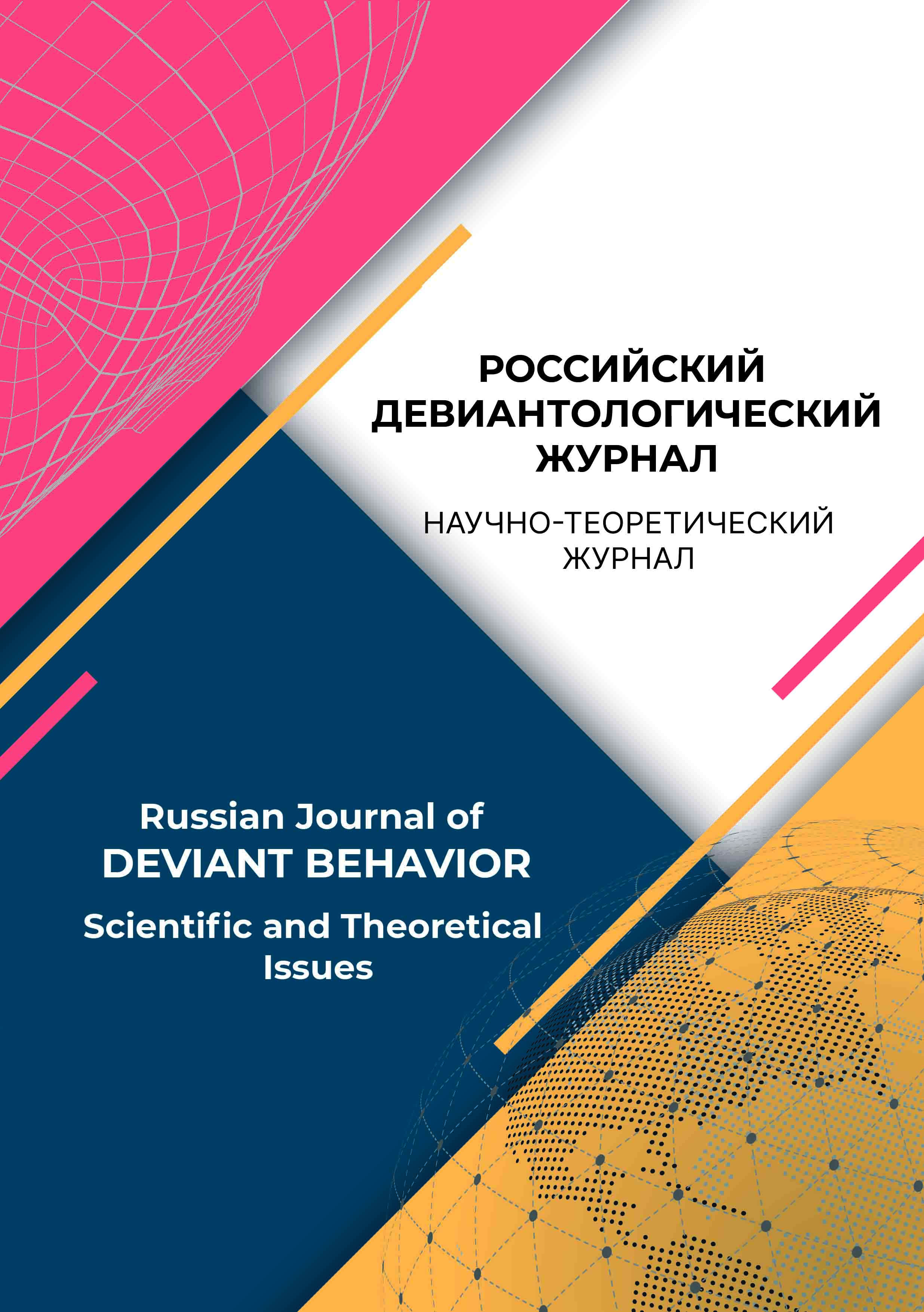Rostov-na-Donu, Rostov-on-Don, Russian Federation
UDC 343.985.7
UDC 346
The article deals with socio-cultural and legal approaches to the prevention of sexual deviations related to coercion and harassment. The author believes that the criminalisation of sexual abuse (including harassment) does not meet the genesis of criminal law regulation, namely the social need for it to be prohibited specifically by criminal law, which is the state’s final argument in combating anti-social behavior. Introduction. The moral and cultural assessment of sexual relations outside of marriage, as well as of non-traditional forms of sexual relations, has changed over time and has had a significant impact on state-legal approaches to ensuring the security of sexual freedom and sexual inviolability of the individual. In this regard, on the modern socio-cultural platform new directions of formation of the state policy in the field of permissible and prohibited in the sexual sphere, the nature of freedom of actions of sexual nature and the degree of public danger of such deviations as coercion to actions of sexual nature and accompanying acts - sexual harassment are born. Aim of the criminological and sociological study was to outline the boundaries of the criminal law prevention of sexual deviations related to compulsion to sexual acts and harassment. Research Methodology, Methods and Techniques. The methodological basis of the study consists of general scientific and particular scientific methods of scientific knowledge, methods of empirical and theoretical research. Dialectics is accepted as a philosophical theory about the universal laws of motion and development of nature, human society and thinking, and in its original sense - as a logic and debatable search for truth related to the object of research. The anthropological approach allows us to reveal the ways in which the perpetrator’s personality is formed, as well as the motives and motivation behind deviant behavior. The axiological approach assists in verifying ways of strengthening the perceptions of sexual freedom as a moral and legal value, both at the level of mass, collective and individual consciousness and at the level of law-making and law enforcement processes systematically related to countering sexual offences. The use of the above approaches and methods ensured the study of sexual deviations, connected with coercion to actions of sexual nature and harassment, as an independent criminological phenomenon. The study found that general and special prevention mechanisms to prevent sexual harassment exist in our country, but are poorly used for various reasons, including the immoral behavior of the victim. The existence of organisational and legal problems for law enforcement agencies in proving reports of sexual offences should be recognised, but this cannot change the social nature of the acts and the degree of their public danger. The international experience of combating sexual harassment against the background of systematic high-profile «sex» scandals is a weak argument in favour of the effectiveness of combating social deviations by criminal law means. Scientific novelty. The study substantiates the author’s position that criminalisation of sexual harassment (including harassment) does not correspond to the genesis of criminal law regulation, i.e. the social need for sexual harassment to be prohibited by criminal law, which is the state’s final argument to combat anti-social behavior. Practical significance. The proposals formulated are aimed at the formation of effective criminal policy in the field of preventive measures to ensure the security of sexual freedom and integrity of the person.
deviant behavior, compulsion to engage in sexual activity, harassment
1. Bavsun, M. V. (2022). Pravovaya transformaciya: ot sovetskoj stabil’nosti k neopredelennosti postmoderna. V N. S. Nizhnik i dr. (red.), sbornik trudov konferencii: Gosudarstvo i pravo: evolyuciya, sovremennoe sostoyanie, perspektivy razvitiya (k 100-letiyu obrazovaniya SSSR): materialy XIX Mezhdunarodnoj nauchno-teoreticheskoj konferencii: v 2 ch. (Tom Chast’ 1, Sankt-Peterburg, str. 1660-1667). Saint Petersburg: Sankt-Peterburgskij universitet Ministerstva vnutrennih del Rossijskoj Federacii.
2. Bibik, O. N. (2017). Kul’turnoe izmerenie ugolovno-pravovyh i kriminologicheskih issledovanij: teoreticheskie i prakticheskie aspekty: monografiya. Moskow: Yurlitinform.
3. Bojko, A. I. (2010). Nravstvenno-religioznye osnovy ugolovnogo prava: monografiya. Moskow: Yurlitinform.
4. Gilinskij, Ya. I. (2023). Ugolovnaya politika obshchestva postmoderna: aktual’nye problemy. V sbornike nauchnyh statej: Aktual’nye problemy kriminologii, yuridicheskoj psihologii i ugolovno-ispolnitel’nogo prava (Ministerstvo obrazovaniya i nauki rossijskoj federacii; Moskovskij gosudarstvennyj yuridicheskij universitet imeni O. E. Kutafina (MGYUA), str. 75-87). Moskow: Prospekt.
5. Dobren’kov, V. I., Kravchenko, A. I. (2006). Fundamental’naya sociologiya: v 15 t. T. 10: Gender. Sem’ya. Rodstvo. Moskow: INFRA-M.
6. Isaeva, A. A. (2020). Legalizaciya odnopolyh soyuzov: konstitucionno-pravovoj obzor. Sravnitel’noe Konstitucionnoe Obozrenie, 2 (135), 72-87. https://doi.org/10.21128/1812-7126-2020-2-72-87
7. Klejmenov, I. M. (2019). Seksual’noe domogatel’stvo: kriminologicheskij i ugolovno-pravovoj aspekty. Vestnik Tomskogo gosudarstvennogo universiteta. Pravo, 32, 42-54. https://doi.org/10.17223/22253513/32/4
8. Konorezov, N. A. (2022). Ponuzhdenie k dejstviyam seksual’nogo haraktera: ugolovno-pravovaya harakteristika i problemy kvalifikacii: dis. … kand. yurid. nauk. Krasnodar.
9. Pyatnickij, B. I. (1910). Polovye izvrashcheniya i ugolovnoe pravo. Mogilev: Tipografiya I. B. Klaza.
10. Tasakov, S. V. (2010). Nravstvennye osnovy ugolovno-pravovyh norm, napravlennyh na ohranu lichnosti, ee prav, svobod i zakonnyh interesov: avtoref. dis. … d-ra yurid. nauk. Ekaterinburg.
11. Forel’, V. (1907). Polovaya zhizn’ i pravo. Lekciya, chitannaya 4-go dekabrya 1906 goda, v central’nom teatre v Lejpcige (per. Yu. Gol’dendaha). Moskow: T-vo skoropechatni A.A. Levenson.
12. Fuks, I. B. (1914). Gomoseksualizm kak prestuplenie. Saint Petersburg: Tipografiya t-va «Obshchestvennaya Pol’za».
13. Araneta, L. V. (2022). Workplace harassment: the realities of the victims. Psychology and Education, 6, 1205-1217, https:// doi.org/10.5281/zenodo.7443074
14. Brown, Ch. S., Biefeld, Sh. D., & Tam, M. J. (2023). Gendered Harassment in Adolescence. In Th. W. Miller (red.), School Violence and Primary Prevention (pp. 133-152). https://doi.org/10.1007/978-3-031-13134-9_5
15. Çıvgın. U. (2023). Reflections of sexual harassment on psychology and media. In G. Sarı (red.), Handbook of Research on Bullying in Media and Beyond (Chapter 4, pp. 49-67). https://doi.org/10.4018/978-1-6684-5426-8.ch004
16. Pogrebin, M. R., Poole, E. D., & Martinez, A. (1992). Accounts of professional misdeeds: the sexual exploitation of clients by psychotherapists. Deviant behavior, 13 (3), 229-252. https://doi.org/10.1080/01639625.1992.9967911














